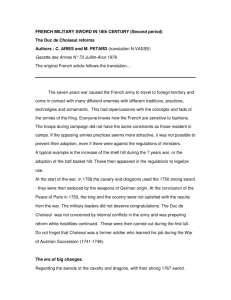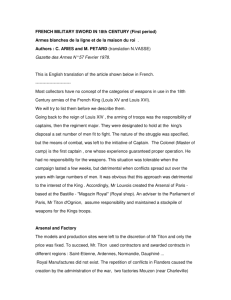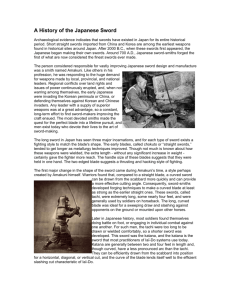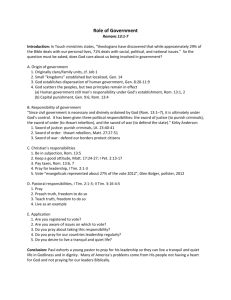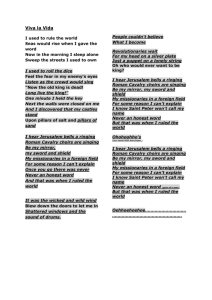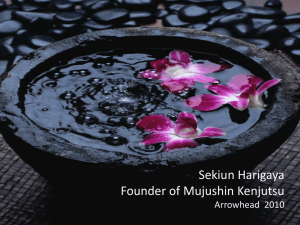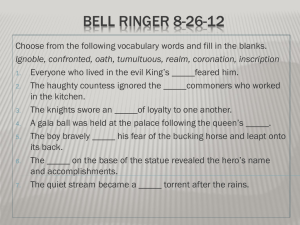FRENCH MILITARY SWORD IN 18th CENTURY (Third period) From
advertisement
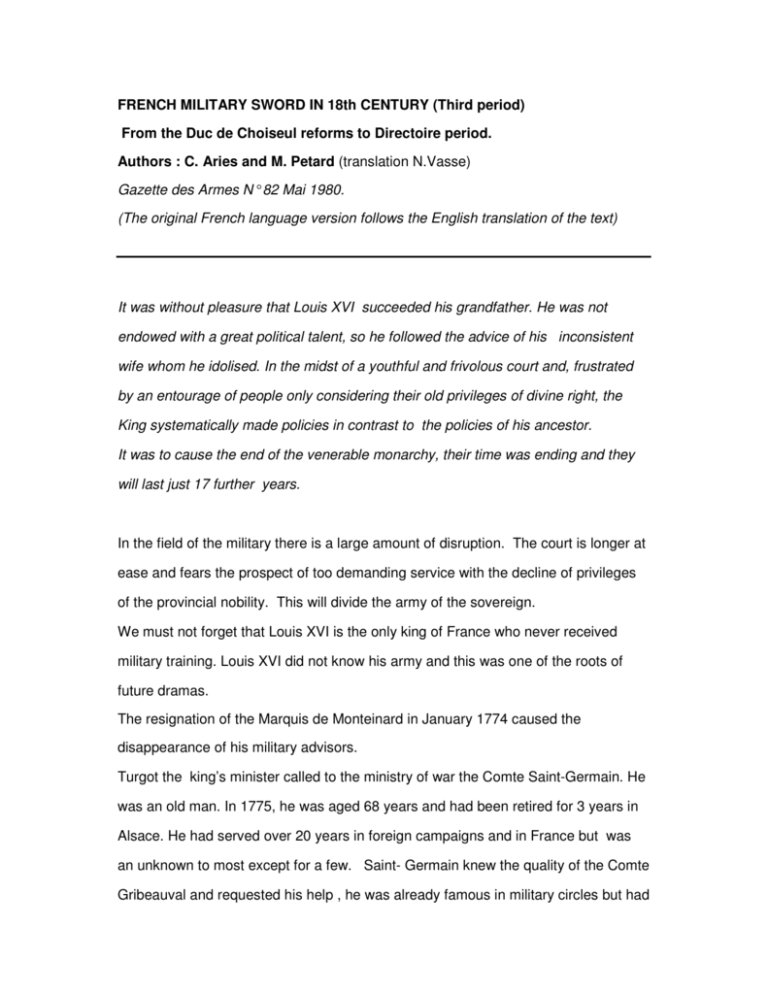
FRENCH MILITARY SWORD IN 18th CENTURY (Third period) From the Duc de Choiseul reforms to Directoire period. Authors : C. Aries and M. Petard (translation N.Vasse) Gazette des Armes N° 82 Mai 1980. (The original French language version follows the English translation of the text) It was without pleasure that Louis XVI succeeded his grandfather. He was not endowed with a great political talent, so he followed the advice of his inconsistent wife whom he idolised. In the midst of a youthful and frivolous court and, frustrated by an entourage of people only considering their old privileges of divine right, the King systematically made policies in contrast to the policies of his ancestor. It was to cause the end of the venerable monarchy, their time was ending and they will last just 17 further years. In the field of the military there is a large amount of disruption. The court is longer at ease and fears the prospect of too demanding service with the decline of privileges of the provincial nobility. This will divide the army of the sovereign. We must not forget that Louis XVI is the only king of France who never received military training. Louis XVI did not know his army and this was one of the roots of future dramas. The resignation of the Marquis de Monteinard in January 1774 caused the disappearance of his military advisors. Turgot the king’s minister called to the ministry of war the Comte Saint-Germain. He was an old man. In 1775, he was aged 68 years and had been retired for 3 years in Alsace. He had served over 20 years in foreign campaigns and in France but was an unknown to most except for a few. Saint- Germain knew the quality of the Comte Gribeauval and requested his help , he was already famous in military circles but had been removed from leadership positions by the disgrace of the Duc de Choiseul, he returned triumphantly and resumed with the changes he had left in 1770. We will not discuss what was done with firearms, as we are devoted to swords. Let's just say that the Comte Saint-Germain arrived with a head full of ideas. Some were interesting, but not all, for example, he imposed a Swedish sword which was a very old weapon with its heyday during the reign of Charles XII of Sweden. The law and the prophets In Sweden, it is referred to as "a la française" and goes back to the time of Louis XIV. This sword will carry the name of Saint-Germain 1776. Strangely it is simply the return of the model 1733. The experience of forty years and two wars are ignored. From the outset everybody wished to reverse its unwanted return. The memory of this model is even deleted from the memory of collectors who often define this sword as a foreign weapon, despite the undeniable marks of French origin. We never see what we do not expect to see. Until it was bettered the sword 1767 survived, especially since peace had not returned to doubt it. However, modernism is at work and worked. All swords with pommels now have an archaic character . In 1779, after numerous studies, a commission of artillery (still responsible for swords) leads to a completely new sword. No one knows the source of its inspiration. The saber has a steel hilt "a fleurons" (with florets) - with a double fullered blade. This blade will have a surprising success in France, particularly in the models Year XIII, 1816 and 1854 and does not disappear with the models 1882 and 1886, after more than a century of service. An very rare officer's saber corresponds to this model 1779 - the same model as the troopers but lighter and decorated. In practice, we realize that this model had drawbacks. The iron oxidizes, the rust attacks the garment in comes into contact with and therefore the iron was replaced by brass. This becomes the 1784 and a 1786 model differs by the thickness of the brass guard. The blade is reinforced compared with the 1779 model. This sword will be the last introduced by the monarchy for the heavy cavalry. The revolution removed the signs of the monarchy (Lys flower) and helped simplify the work of national workshops. Producing the blades we commonly find. Straight blades from all sources were suitable for all kinds of hilt. These weapons are sometimes marked with the rooster or "faisceau de licteur " (beam lictor - revolutionary stamp ) they are trademarks of the national workshops. Revolutionary shortages The shortage of brass at the beginning of the revolution caused a short return of the iron hilt. There were two models,. The revolutionary year IV (1795-96) for heavy cavalry and Dragoons. The blades were also simplified and retuned to one fullered blades (no more double fullered) which were easier to manufacture. The peace with Spain allowed the return of brass and the models year IV were then abandoned. From the beginning of the consulate, the heavy cavalry regiments were transformed into Cuirassiers and received the year IX model (1800-1801). The old "fleurons" hilt was then reserved for Dragoons . Finally this "fleurons" hilt will disappear. The dragoons received the year XIII model as they did not have a year IX model. While the 1784-86 sword model was for the heavy cavalry, the officers, as dragoons officers still had the model 1767 with iron hilt and 3 branches in a "N" (see annex photography). There will be no "fleurons" hilt for officers but in 1784 the "Garde de bataille" (battle guard) hilt was born. At that time, the pommel is oval and stayed like that until 1810. As well as the shell hilt others will have attributes like grenades etc. They do not make their appearance until later however. It started during the consulate period by the addition of a silver grenade for certain officers of the Carabinier. The "shell" hilt officers sword from cavalry and dragoons can be differentiated only by their scabbards. Cavalry have 2 brass furnishings , dragoon have 3 furnishings with 2 in steel and one in brass (the chape). Those differences are found in troopers swords too. The blade with the shell hilt are generaly double fullered, blued and decorated with gold for a third of their lengths, but there are many exceptions. For the dragoons , we must provide a little background. During the monarchy , they never had the "fleurons " hilt. From the Choiseul reform they retained the half basket hilt of the 1767 model and then the 1770 model with straight flat blade with 3 scabbard furnishings ( with brass chape). In 1781, the blade becomes curved and double fullered. This is this sword that will become the sword call the "Montmorency", so beloved of the 2nd Chasseur (old Dragon Montmorency regiment)- see annex. There will be no change until the Revolution. In 1790, the "Chasseurs a cheval" whose weapon was of the dragon type (from which they were derived), receive a sword that was a compromise between their ancient dragon sword and the sword of the light cavalry in which role they are now to serve. The blade is less curved compared the Hussar blade, half basket hilt with diamond guard. The scabbard has 3 brass furnishings. The "Chasseurs" officers did not wear the "garde de bataille" hilt (like dragoons officers) but will also have a decorated half basket hilt. The dragoon often uses the "chasseur " 1790 model, this was used alongside the "fleurons " hilt sword until the consulate period. The "chasseurs" identified with the hussars and at different times, in addition to the model "chasseur", will be armed with a simple branch sword like Hussar " à la Hussarde". These being supplied by private manufacturing. The officers will also follow this trend. This is true until January 1792 (* see photography n°6 in annex), the date on which they received a particular model with a simple branch, it should not be confused with the Hussar model Many variations of this January 1792 model were used often by officers or military administration directors. The regulations of the Duke of Choiseul had equipped the hussars with the 1767 sword. With the new King they received a model in 1783, 1786 and a variant in 1790 ; there is also a particular model called Colonel-General regiment model of 1780. It takes a lot of experience to differentiate these models, the features are subtle. Revolutionary manufacturing will make it even more difficult to recognise the models. There is an exception and that is the year IV (1895-96) model. Copper shortages caused the scabbard of these models to be lined with iron, not brass as had always been the case with the hussars. Finally, the control system of the year IX regulation leads to the model year IX, ending the tradition of specialized sabers which began in 1750 (see previous article). German Inspiration As we know the officers of Hussars never had a regulatory model. The swords of new officers will approach the regulatory models. They will find their inspiration with weapons in use in Austria and Germany in the Holy Roman Empire. We see a profusion of models – Beaded guards, scabbards with extravagant furnishings ... these are not part of the French tradition but the revolution and the empire will quickly adopt them. Passing mention should be made to the small sabres with iron scabbards and hilt witch conserve the traditional elegance. "Not everything is rotten in the kingdom of France!". The carabiniers lost their 1777 pommel hilt . They then received a new weapon whose blade is called "de Monsieur" . The hilt kept the shell with arms of France and stamped with a royal crown. In republican year IV, the pattern changes, the emblems of monarchy are replaced by a grenade with a stylized flame silhouette evokes a ‘pinecone’ - the nickname of the sword ‘pinecone’ is born. The blade is engraved "Carabiniers de la République Française". The carabiniers will gradually lose their particular sword. Long serving Carabiniers officers use the 1760 model called "De Monsieur de Crémille" (* see annex ) in competition with a fantasy model from Germany with a shell and 2 branches. The shell is decorated with the arms of France, such non-regulatory, and there are many variants. These two hilts come together is a sort of merger to give a hilt called "a la Marguerite". This will never be prescribed, but it had a history of long use and can be found at the end of the empire almost identical. The shell is perforated and decorated with a silver grenade fixed by claws or cast iron and gold the same as the hilt. The royal German regiment has an old curved 1750 model sword pommel and scabbard 1767 model. This regiment disappears during the revolutionary period . La Maréchaussée (police) For a long time were armed with a sword with "pas d'âne" ring. The dates of adoption are not known. They finally received in 1783, a specific weapon. A flat blade with palm hilt. In the words of Cotty, even when the Marechausée had usurped the name of the Gendarmerie, they were so attached to this sword that they did not abandon it. The result of this commitment is the incredible number of these swords from private manufacture. Officers who always wanted to be treated as the gendarmerie in the kings household always preferred the sword of the musketeer. They do not choose the big and expensive ‘Wallonne’ sword which had multiple branches that the Gendarmerie alone kept until the dissolution in 1788 . In 1787, officers of the Marechaussée received a sword blade that was straight and flat, fairly light and with a hilt that had 5 elegant branches. It, remained long in use (see annex n°10). We must say a word about what happens in the king's military household: The "Garde du corps" (bodyguards) still wore a sword. In 1784,by modifying their uniforms, they lose their ancient Walloone sword. They then received a new weapon, and hilt innovation. It has a prestigious future. It is the ancestor of the four branch hilt of the heavy cavalry, ancestor of the Year XI model, ancestor of 1816 and 1854 model. It does not disappear until the models 1882 and 1886. It's now necessary to speak a little about the smallsword with specific characters. With the Gardes du corps - the smallsword (see annex) blade has 3 edges and keeps the same engravings. Hilt is a single knuklebow with oval shells. This hilt become more decorative. This sword disappears with the revolution and then is further modified to reappear in the restoration period. About Gendarmerie of France…. their Hilt is called "à la Française", that means that the branch is prolonged by a double quillon (see first period paper), the guard platter has a lyre form and is separated by the quillon. About Carabiniers…. the carabiniers smallsword keeps its form " a la mousquetaire " (musketer - see first period paper). Infantry officers carried the same weapon in any circumstance. The 1767 model with "pas d'âne rings" is modified in 1779 - gilt silver wire replace silver - this model is a replacement for the "a la Française" hilt in 1784 (see table), it's not in reality a new model, Gendarmerie corps and French guards wear this smallsword. The 1784 model, is going through the revolution and ends as the Vendemiaire Year XIII model called "a la Française". It is not possible to write an article on all the many variants of this period , There is no service of the army or the administration that does not forge a specimen of sword. Incidentally, we should mention a short sword for "chasseur à pied" (walking Chasseur) officers in 1788. The early regulations do not define it and give no description of it. This sword will become the preferred weapon for officers of Elite companies. The sword in the infantry disappears in favour of the "briquet" (see 2nd period paper), which is worn by sergeants and corporals, the company elite, drums and sapeurs. At the beginning of the reign of Louis XVI, this was the model 1767 (or 1770). During his reign we add the models 1784 and 1790. They differ only in subtleties of manufacture or engraving on the blade Artillery The artillery was separate from the infantry. When the Comte Gribeauval returned he resumed his reforms started in the Ministry of the Duc de Choiseul. Consequently, there was no change to what had already been done before his disgrace. The ordinances of 1772 and 1774, relate only to organizational matters. We know that since 1771 the artillery possess a strange sword called "glaive " (glaveus). The gunners were attached to this sword and it had a long career. 1792 saw the birth of the horse artillery who will enjoy a bright future. It is intended that there will be no small change to what exists. It adopts the "briquet" blade and on the hilt it replaces the eagle's head by a lion and adds a branch. This hybrid was not a great success and dies with the century. The sapper's sword had considerable prestige. We do not know the date of adoption. The French and Swiss guards seem to have been the first to wear them including soldiers called gunner and carpenters. The surviving examples show variations. These are decorative objects but devoid of any regulatory character. The style depended on the commanders vanity . Another weapon that will enjoy a extraordinary popularity - it is the sword called " de mineur" (pit worker). Although we do not know when it was adopted, the sword must be later than 1779, the date of separation from the corps of engineers and artillery. This sword will become the little "Montmorency" and be adopted by the volunteers of the revolution. There were hundreds of variations from simple to more expensive artwork. All military and civilians adopted this Republican object. The model disappeared when the military seized power. The wars of the revolution were just one stage in the history of French weapons. The period of the Directory will calm the fury of the Convention. General Bonaparte had already arrived bringing in a new situation and new weapons ... Iconography translation 1. King cavalry regiment. The man wears a 1776 uniform with a sword with 3 branches and 2 pontat - a 1767 cavalry model 2. Gendarmes from Scotish company circa. 1776. 1772 uniform and Wallone sword. 3. 1784 Cavalry sabre "a fleurons". in brass, the blade is double fullered - note the hole for the knot sword . 4. The museum's collection of Fontainebleau . From left to right and from top to bottom we recognize the sabers: - Officer of the 1787 model Maréchausée (police) - Cavalry and dragoons 1783 with its "fleurons" ( lys : king flower) - A cavalry officer in custody battle in 1784 - Cavalry and dragoons 1783 with its revolutionary "fleurons" - Second Chasseur half-iron basket hilt. Under sabre: - 1790 model for Chasseur - 1790 palm guard for Marechaussée - 1779 iron cavalry with is Lys flower , rare - 1783 but révolution model below saber: - 1786 Hussar model - 1792 artillery model •TABLE of the French Monarchy Sword evolution Annex added by n.Vasse from the Dr Lacroix collection: 1 Sword with "double pontat" 2 Expensive sword of GENDARME DE LA MAISON DU ROI (Walonne) 3 Infantry Officer modèle 1767 4 SABRE of GRENADIER modèle 1767 5 SABRE of MARINE troops. 6 Sabre Janvier 1792 model 7 OFFICER of CHASSEURS À CHEVAL SABRE 8 HUSSAR OFFICER SABRE 9 SABRE of LA MARÉCHAUSSÉE modèle 1783 10 SABRE of LA MARÉCHAUSSÉE OFFICER modèle 1787 11OFFICER of GENDARMERIE aux trois ordres 12 DRAGOON Troops modèle 1784 called "a Fleuron" 13 and 14. CHASSEUR À CHEVAL(modéle 2éme chasseur) troop modèle 1790 15 HUSSAR troop modèle 1786 16. Model 1767 with iron hilt and 3 branches in "N" for Dragoon officers. (from les épées portées en France J. LHOSTE) 17. De monsieur de Gremille model (from les épées portées en France J. LHOSTE) 18. Smallsword of Garde du corps (from les épées portées en France J. LHOSTE) 19. Small sword for Infantry officers 1767 model (from les épées portées en France J. LHOSTE)
